Exploring the Climate and Topography of Olive Orchards in Extremadura, Southwestern Spain
Abstract
:1. Introduction
2. Materials and Methods
2.1. Study Area
2.2. Database
2.3. Modelling
3. Results and Discussion
3.1. Topographical Characterisation
3.2. Temperature Characterisation
3.3. Precipitation Characterisation
3.4. Frost Characterisation
3.5. Relationship between Altitude and Climatic Variables in the Olive Grove Area in Extremadura
4. Conclusions
Supplementary Materials
Author Contributions
Funding
Data Availability Statement
Acknowledgments
Conflicts of Interest
References
- FAOSTAT. Available online: https://www.fao.org/faostat/es/#data/QCL (accessed on 5 May 2023).
- Ministerio de Agricultura Pesca y Alimentación Anuario de Estadística. Available online: https://www.mapa.gob.es/es/estadistica/temas/publicaciones/anuario-de-estadistica/2021/default.aspx?parte=3&capitulo=07&grupo=12 (accessed on 19 April 2023).
- European Union (EU). Statistics | Eurostat. Available online: https://ec.europa.eu/eurostat/databrowser/view/ORCH_TOTAL__custom_5826819/default/table?lang=en (accessed on 19 April 2023).
- EUROSTAT. Aceite de Oliva. Available online: https://agriculture.ec.europa.eu/farming/crop-productions-and-plant-based-products/olive-oil_es (accessed on 20 April 2023).
- Agovino, M.; Casaccia, M.; Ciommi, M.; Ferrara, M.; Marchesano, K. Agriculture, Climate Change and Sustainability: The Case of EU-28. Ecol. Indic. 2019, 105, 525–543. [Google Scholar] [CrossRef]
- Calzadilla, A.; Rehdanz, K.; Betts, R.; Falloon, P.; Wiltshire, A.; Tol, R.S.J. Climate Change Impacts on Global Agriculture. Clim. Chang. 2013, 120, 357–374. [Google Scholar] [CrossRef]
- Di Vaio, C.; Nocerino, S.; Paduano, A.; Sacchi, R. Influence of Some Environmental Factors on Drupe Maturation and Olive Oil Composition. J. Sci. Food Agric. 2013, 93, 1134–1139. [Google Scholar] [CrossRef] [PubMed]
- Lombardo, N.; Marone, E.; Fiorino, P.; Godino, G.; Madeo, A.; Alessandrino, M. Influence of Growing Season Temperatures in the Fatty Acids (FAs) of Triacilglycerios (TAGs) Composition in Italian Cultivars of Olea Europaea. Adv. Hort. Sci. 2008, 22, 49–53. [Google Scholar]
- Pérez-López, D.; Ribas, F.; Moriana, A.; Rapoport, H.F.; De Juan, A. Influence of Temperature on the Growth and Development of Olive (Olea europaea L.) Trees. J. Hortic. Sci. Biotechnol. 2008, 83, 171–176. [Google Scholar] [CrossRef]
- Fraga, H.; Moriondo, M.; Leolini, L.; Santos, J.A. Mediterranean Olive Orchards under Climate Change: A Review of Future Impacts and Adaptation Strategies. Agronomy 2020, 11, 56. [Google Scholar] [CrossRef]
- Fraga, H.; Pinto, J.G.; Viola, F.; Santos, J.A. Climate Change Projections for Olive Yields in the Mediterranean Basin. Int. J. Climatol. 2020, 40, 769–781. [Google Scholar] [CrossRef]
- Ponti, L.; Gutierrez, A.P.; Basso, B.; Neteler, M.; Ruti, P.M.; Dell’Aquila, A.; Iannetta, M. Olive Agroecosystems in the Mediterranean Basin: Multitrophic Analysis of Climate Effects with Process-Based Representation of Soil Water Balance. Procedia Environ. Sci. 2013, 19, 122–131. [Google Scholar] [CrossRef]
- Giorgi, F.; Lionello, P. Climate Change Projections for the Mediterranean Region. Glob. Planet. Chang. 2008, 63, 90–104. [Google Scholar] [CrossRef]
- Tombesi, A.; Tombesi, S.; Sbitri, M.O.; Serafini, F. Orchard Planning and Planting. In Production Tecniques in Olive Growing; International Olive Council: Madrid, Spain, 2007; pp. 17–40. [Google Scholar]
- Therios, I. Olives: Crop Production Science in Horticulture; CABI: Wallingford, UK, 2009. [Google Scholar]
- Lodolini, E.M.; Alfei, B.; Cioccolanti, T.; Zucchini, M.; Neri, D. Comparison of Frost Damages in Eleven Olive Cultivars after Two Freezing Events in Central Italy. Acta Hortic. 2022, 1346, 161–168. [Google Scholar] [CrossRef]
- Mohamed Mousa, Y.; Gerasopoulos, D.; Metzidakis, I.; Kiritsakis, A. Effect of Altitude on Fruit and Oil Quality Characteristics of ‘Mastoides’ Olives. J. Sci. Food Agric. 1996, 71, 345–350. [Google Scholar] [CrossRef]
- Mafrica, R.; Piscopo, A.; De Bruno, A.; Poiana, M. Effects of Climate on Fruit Growth and Development on Olive Oil Quality in Cultivar Carolea. Agriculture 2021, 11, 147. [Google Scholar] [CrossRef]
- Giorgi, F. Climate Change Hot-Spots. Geophys. Res. Lett. 2006, 33, L08707. [Google Scholar] [CrossRef]
- Tuel, A.; Eltahir, E. Why Is the Mediterranean a Climate Change Hot Spot? J. Clim. 2020, 33, 5829–5843. [Google Scholar] [CrossRef]
- Bladé, I.; Cacho, I.; Castro-Díez, Y.; Gomis Bosch, D.; Gonzalez Samperiz, P.; Miguez-Macho, G.; Perez, F.F.; Rodriguez-Fonseca, M.B.; Rodriguez-Puebla, C.; Sanchez, E.; et al. Clima En España: Pasado, Presente y Futuro. In Informe de Evaluación Del Cambio Climático Regional; Pérez y Roberta Boscolo, F.F., Ed.; CLIVAR España: Madrid, Spain, 2010. [Google Scholar]
- Esteban-Parra, M.J.; Rodrigo, F.S.; Castro-Diez, Y. Spatial and Temporal Patterns of Precipitation in Spain for the Period 1880–1992. Int. J. Climatol. 1998, 18, 1557–1574. [Google Scholar] [CrossRef]
- Brunetti, M.; Maugeri, M.; Monti, F.; Nanni, T. Temperature and Precipitation Variability in Italy in the Last Two Centuries from Homogenised Instrumental Time Series. Int. J. Climatol. 2006, 26, 345–381. [Google Scholar] [CrossRef]
- Brunet, M.; Sigró, J.; Jones, P.; Saladié, Ò.; Aguilar, E.; Moberg, A.; Lister, D.; Walther, A. Long-Term Changes in Extreme Temperatures and Precipitation in Spain. Contrib. Sci. 2007, 3, 331–342. [Google Scholar]
- Tanasijevic, L.; Todorovic, M.; Pereira, L.S.; Pizzigalli, C.; Lionello, P. Impacts of Climate Change on Olive Crop Evapotranspiration and Irrigation Requirements in the Mediterranean Region. Agric. Water Manag. 2014, 144, 54–68. [Google Scholar] [CrossRef]
- Aguilera, F.; Fornaciari, M.; Ruiz-Valenzuela, L.; Galán, C.; Msallem, M.; Ben Dhiab, A.; la Guardia, C.D.; del Mar Trigo, M.; Bonofiglio, T.; Orlandi, F. Phenological Models to Predict the Main Flowering Phases of Olive (Olea europaea L.) along a Latitudinal and Longitudinal Gradient across the Mediterranean Region. Int. J. Biometeorol. 2015, 59, 629–641. [Google Scholar] [CrossRef] [PubMed]
- García-Mozo, H.; Mestre, A.; Galán, C. Phenological Trends in Southern Spain: A Response to Climate Change. Agric. For. Meteorol. 2010, 150, 575–580. [Google Scholar] [CrossRef]
- D’Imperio, M.; Dugo, G.; Alfa, M.; Maninia, L.; Segre, A. Statistical Analysis on Sicilian Olive Oils. Food Chem. 2007, 102, 956–965. [Google Scholar] [CrossRef]
- Servili, M.; Esposto, S.; Fabiani, R.; Urbani, S.; Taticchi, A.; Mariucci, F.; Selvaggini, R.; Montedoro, G.F. Phenolic Compounds in Olive Oil: Antioxidant, Health and Organoleptic Activities According to Their Chemical Structure. Inflammopharmacology 2009, 17, 76–84. [Google Scholar] [CrossRef]
- Greven, M.; Neal, S.; Green, S.; Dichio, B.; Clothier, B. The Effects of Drought on the Water Use, Fruit Development and Oil Yield from Young Olive Trees. Agric. Water Manag. 2009, 96, 1525–1531. [Google Scholar] [CrossRef]
- Fernandes-Silva, A.A.; Ferreira, T.C.; Correia, C.M.; Malheiro, A.C.; Villalobos, F.J. Influence of Different Irrigation Regimes on Crop Yield and Water Use Efficiency of Olive. Plant Soil 2010, 333, 35–47. [Google Scholar] [CrossRef]
- Nissim, Y.; Shloberg, M.; Biton, I.; Many, Y.; Doron-Faigenboim, A.; Zemach, H.; Hovav, R.; Kerem, Z.; Avidan, B.; Ben-Ari, G. High Temperature Environment Reduces Olive Oil Yield and Quality. PLoS ONE 2020, 15, e0231956. [Google Scholar] [CrossRef] [PubMed]
- Rodríguez Sousa, A.A.; Barandica, J.M.; Aguilera, P.A.; Rescia, A.J. Examining Potential Environmental Consequences of Climate Change and Other Driving Forces on the Sustainability of Spanish Olive Groves under a Socio-Ecological Approach. Agriculture 2020, 10, 509. [Google Scholar] [CrossRef]
- Orlandi, F.; Rojo, J.; Picornell, A.; Oteros, J.; Pérez-Badia, R.; Fornaciari, M. Impact of Climate Change on Olive Crop Production in Italy. Atmosphere 2020, 11, 595. [Google Scholar] [CrossRef]
- Andrade, C.; Fonseca, A.; Santos, J.A. Are Land Use Options in Viticulture and Oliviculture in Agreement with Bioclimatic Shifts in Portugal? Land 2021, 10, 869. [Google Scholar] [CrossRef]
- Arenas-Castro, S.; Gonçalves, J.F.; Moreno, M.; Villar, R. Projected Climate Changes Are Expected to Decrease the Suitability and Production of Olive Varieties in Southern Spain. Sci. Total Environ. 2020, 709, 136161. [Google Scholar] [CrossRef]
- Gabaldón-Leal, C.; Ruiz-Ramos, M.; de la Rosa, R.; León, L.; Belaj, A.; Rodríguez, A.; Santos, C.; Lorite, I.J. Impact of Changes in Mean and Extreme Temperatures Caused by Climate Change on Olive Flowering in Southern Spain. Int. J. Climatol. 2017, 37, 940–957. [Google Scholar] [CrossRef]
- Fraga, H.; Pinto, J.G.; Santos, J.A. Olive Tree Irrigation as a Climate Change Adaptation Measure in Alentejo, Portugal. Agric. Water Manag. 2020, 237, 106193. [Google Scholar] [CrossRef]
- Moreno, J.; Aguiló, E.; Alonso, S.; Álvarez Cobelas, M.; Anadón, R.; Ballester, F.; Benito, G.; Catalán, J.; De Castro, M.; Cendrero, A.; et al. Evaluación Preliminar de Los Impactos En España Por Efecto Del Cambio Climático; Centro de Publicaciones Ministerio de Medio Ambiente: Madrid, Spain, 2005. [Google Scholar]
- Folgado-Fernández, J.A.; Campón-Cerro, A.M.; Hernández-Mogollón, J.M. Potential of Olive Oil Tourism in Promoting Local Quality Food Products: A Case Study of the Region of Extremadura, Spain. Heliyon 2019, 5, e02653. [Google Scholar] [CrossRef]
- Hrnjak, I.; Lukić, T.; Gavrilov, M.B.; Marković, S.B.; Unkašević, M.; Tošić, I. Aridity in Vojvodina, Serbia. Theor. Appl. Climatol. 2014, 115, 323–332. [Google Scholar] [CrossRef]
- Fraga, H.; Malheiro, A.C.; Moutinho-Pereira, J.; Cardoso, R.M.; Soares, P.M.M.; Cancela, J.J.; Pinto, J.G.; Santos, J.A. Integrated Analysis of Climate, Soil, Topography and Vegetative Growth in Iberian Viticultural Regions. PLoS ONE 2014, 9, e108078. [Google Scholar] [CrossRef]
- Liu, X.; Zhang, D.; Luo, Y.; Liu, C. Spatial and Temporal Changes in Aridity Index in Northwest China: 1960 to 2010. Theor. Appl. Climatol. 2013, 112, 307–316. [Google Scholar] [CrossRef]
- Moral, F.J.; Rebollo, F.J.; Valiente, P.; López, F. Modeling of Atmospheric Pollution in Urban and Rural Sites Using a Probabilistic and Objective Approach. Appl. Sci. 2019, 9, 4009. [Google Scholar] [CrossRef]
- Blanco Salas, J.; Labrador, J.; Monago, F.; Vallejo, J.R.; Morán-López, R.; Vázquez, F.M.; Ruiz Téllez, T. Resultados Del Proyecto “Valorización de La Biodiversidad Vegetal Del Espacio Protegido ZIR Sierra Grande de Hornachos Como Fuente de Innovación Para El Desarrollo”. Conserv. Veg. 2020, 24, 10. [Google Scholar]
- SNCZI-Inventario de Presas y Embalses. Available online: https://sig.mapama.gob.es/snczi/index.html?herramienta=EstadisticasPresas (accessed on 4 May 2023).
- Facultad de Ciencias Económicas y Empresariales y Escuela de Ingenierías Agrarias, Universidad de Extremadura. La Agricultura y La Ganadería Extremeñas, 2018; Fundacion Caja Badajoz: Badajoz, Spain, 2019. [Google Scholar]
- Secretaría General de la Consejería de Agricultura y Política Agraria Comunitaria, G. de E. SIGPAC 2021-CC-BY4.0 CICTEX. Available online: http://sitex.gobex.es/SITEX/centrodescargas/view/11 (accessed on 8 April 2024).
- CE (Comunidad Europea). Reglamento (CE) No 2138/97 de La Comisión de 30 de Octubre de 1997; CE: Brussels, Belgium, 1997. [Google Scholar]
- UE (Unión Europea). Reglamento (CE) No 148/2007 de La Comisión de 15 de Febrero de 2007; UE: Brussels, Belgium, 2007. [Google Scholar]
- UE (Unión Europea). Reglamento (CE) No 240/2007 de La Comisión, de 6 de Marzo de 2007, Por El Que Se Registran Ciertas Denominaciones En El ’Registro de Denominaciones de Origen Protegidas e Indicaciones Geográficas Protegidas; UE: Brussels, Belgium, 2007. [Google Scholar]
- Extremadura. Decreto 128/2022, de 11 de Octubre, Por El Que Se Aprueba El Reglamento de La Denominación de Origen Protegida “Aceite Villuercas Ibores Jara”; Junta de Extremadura: Merida, Spain, 2022. [Google Scholar]
- AEMET Agencia Estatal de Meteorología (AEMET). Available online: https://www.aemet.es/es/portada (accessed on 16 February 2024).
- WMO World Meteorological Organization. Annual Report of the World Meteorological Organization 1966; WMO: Geneva, Switzerland, 1967. [Google Scholar]
- KNMI Royal Netherlands Meteorological Institute; ECAD European Climate Assessment & Dataset. Algorithm Theoretical Basis Document; Royal Netherlands Meteorological Institute KNMI: Utrecht, The Netherlands, 2013. [Google Scholar]
- OMS Organización Meteorológica Mundial. Guía de Prácticas Climatológicas; OMM: Geneva, Switzerland, 2018; ISBN 9789263301000. [Google Scholar]
- Guijarro, J. Homogenization of Climatic Series with Climatol; CLIMATOL, AEMET: Balearic Islands, Spain, 2018; Available online: https://climatol.eu/ (accessed on 8 April 2024).
- García-Martín, A.; Paniagua, L.L.; Moral, F.J.; Rebollo, F.J.; Rozas, M.A. Spatiotemporal Analysis of the Frost Regime in the Iberian Peninsula in the Context of Climate Change (1975–2018). Sustainability 2021, 13, 8491. [Google Scholar] [CrossRef]
- Ministerio de Transportes y Movilidad Sostenible Instituto Geográfico Nacional IGN. Available online: https://www.ign.es/web/cbg-area-cartografia (accessed on 5 April 2024).
- Bustamante, J. Cartografía Predictiva de Variables Climáticas: Comparación de Distintos Modelos de Interpolación de La Temperatura En España Peninsular. Graellsia 2003, 59, 359–376. [Google Scholar] [CrossRef]
- Goovaerts, P. Using Elevation to Aid the Geostatistical Mapping of Rainfall Erosivity. Catena 1999, 34, 227–242. [Google Scholar] [CrossRef]
- Odeh, I.O.A.; McBratney, A.B.; Chittleborough, D.J. Further Results on Prediction of Soil Properties from Terrain Attributes: Heterotopic Cokriging and Regression-Kriging. Geoderma 1995, 67, 215–226. [Google Scholar] [CrossRef]
- Mailer, R.J.; Ayton, J.; Graham, K. The Influence of Growing Region, Cultivar and Harvest Timing on the Diversity of Australian Olive Oil. J. Am. Oil Chem. Soc. 2010, 87, 877–884. [Google Scholar] [CrossRef]
- Osman, M.; Metzidakis, I.; Gerasopoulos, D.; Kiritsakis, A. Qualitative Changes in Olive Oil of Fruits Collected from Trees Grown at Two Altitudes. Riv. Ital. Sostanze Grasse 1994, 71, 187–190. [Google Scholar]
- Trentacoste, E.R.; Connor, D.J.; Gómez-del-Campo, M. Effect of Olive Hedgerow Orientation on Vegetative Growth, Fruit Characteristics and Productivity. Sci. Hortic. 2015, 192, 60–69. [Google Scholar] [CrossRef]
- Trentacoste, E.R.; Gómez-del-Campo, M.; Rapoport, H.F. Olive Fruit Growth, Tissue Development and Composition as Affected by Irradiance Received in Different Hedgerow Positions and Orientations. Sci. Hortic. 2016, 198, 284–293. [Google Scholar] [CrossRef]
- Tang, Z.; Fang, J. Temperature Variation along the Northern and Southern Slopes of Mt. Taibai, China. Agric. For. Meteorol. 2006, 139, 200–207. [Google Scholar] [CrossRef]
- Krishna, K.R. Agroecosystems: Soils, Climate, Crops, Nutrient Dynamics and Productivity; Apple Academic Press: New York, NY, USA, 2013; ISBN 9780429170980. [Google Scholar]
- Mousavi, S.; de la Rosa, R.; Moukhli, A.; El Riachy, M.; Mariotti, R.; Torres, M.; Pierantozzi, P.; Stanzione, V.; Mastio, V.; Zaher, H.; et al. Plasticity of Fruit and Oil Traits in Olive among Different Environments. Sci. Rep. 2019, 9, 16968. [Google Scholar] [CrossRef] [PubMed]
- Ramos-Román, M.J.; Jiménez-Moreno, G.; Anderson, R.S.; García-Alix, A.; Camuera, J.; Mesa-Fernández, J.M.; Manzano, S. Climate Controlled Historic Olive Tree Occurrences and Olive Oil Production in Southern Spain. Glob. Planet. Chang. 2019, 182, 102996. [Google Scholar] [CrossRef]
- Rodrigo-Comino, J.; Senciales-González, J.M.; Yu, Y.; Salvati, L.; Giménez-Morera, A.; Cerdà, A. Long-Term Changes in Rainfed Olive Production, Rainfall and Farmer’s Income in Bailén (Jaén, Spain). EuroMediterr J. Environ. Integr. 2021, 6, 58. [Google Scholar] [CrossRef]
- Galán, C.; Vázquez, L.; García-Mozo, H.; Domínguez, E. Forecasting Olive (Olea europaea) Crop Yield Based on Pollen Emission. Field Crops Res. 2004, 86, 43–51. [Google Scholar] [CrossRef]
- Galán, C.; Cariñanos, P.; García-Mozo, H.; Alcázar, P.; Domínguez-Vilches, E. Model for Forecasting Olea Europaea L. Airborne Pollen in South-West Andalusia, Spain. Int. J. Biometeorol. 2001, 45, 59–63. [Google Scholar] [CrossRef] [PubMed]
- Barranco, D.; Ruiz, N.; Campo, M.G. Frost Tolerance of Eight Olive Cultivars. HortScience 2005, 40, 558–560. [Google Scholar] [CrossRef]
- Valverde, P.; Zucchini, M.; Polverigiani, S.; Lodolini, E.M.; López-Escudero, F.J.; Neri, D. Olive Knot Damages in Ten Olive Cultivars after Late-Winter Frost in Central Italy. Sci. Hortic. 2020, 266, 109274. [Google Scholar] [CrossRef]
- Bartolozzi, F.; Cerquaglia, F.; Coppari, L.; Fontanazza, G. Frost tolerance induced by cold acclimation in olive (Olea europaea) L. Acta Hortic. 2002, 586, 473–477. [Google Scholar] [CrossRef]
- Lodolini, E.M.; Alfei, B.; Santinelli, A.; Cioccolanti, T.; Polverigiani, S.; Neri, D. Frost Tolerance of 24 Olive Cultivars and Subsequent Vegetative Re-Sprouting as Indication of Recovery Ability. Sci. Hortic. 2016, 211, 152–157. [Google Scholar] [CrossRef]
- Oteros, J.; García-Mozo, H.; Vázquez, L.; Mestre, A.; Domínguez-Vilches, E.; Galán, C. Modelling Olive Phenological Response to Weather and Topography. Agric. Ecosyst. Environ. 2013, 179, 62–68. [Google Scholar] [CrossRef]
- Alikadic, A.; Pertot, I.; Eccel, E.; Dolci, C.; Zarbo, C.; Caffarra, A.; De Filippi, R.; Furlanello, C. The Impact of Climate Change on Grapevine Phenology and the Influence of Altitude: A Regional Study. Agric. For. Meteorol. 2019, 271, 73–82. [Google Scholar] [CrossRef]
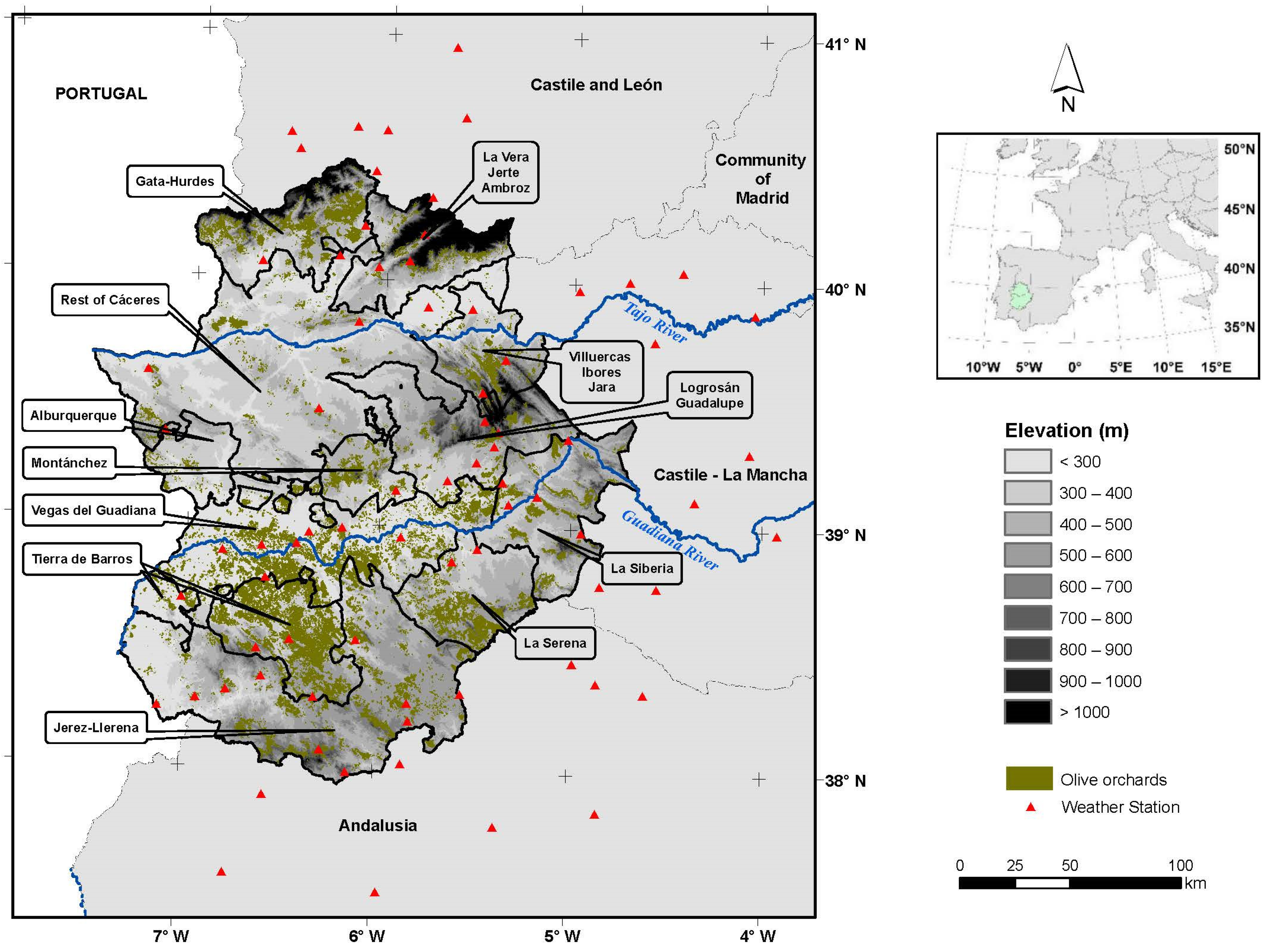
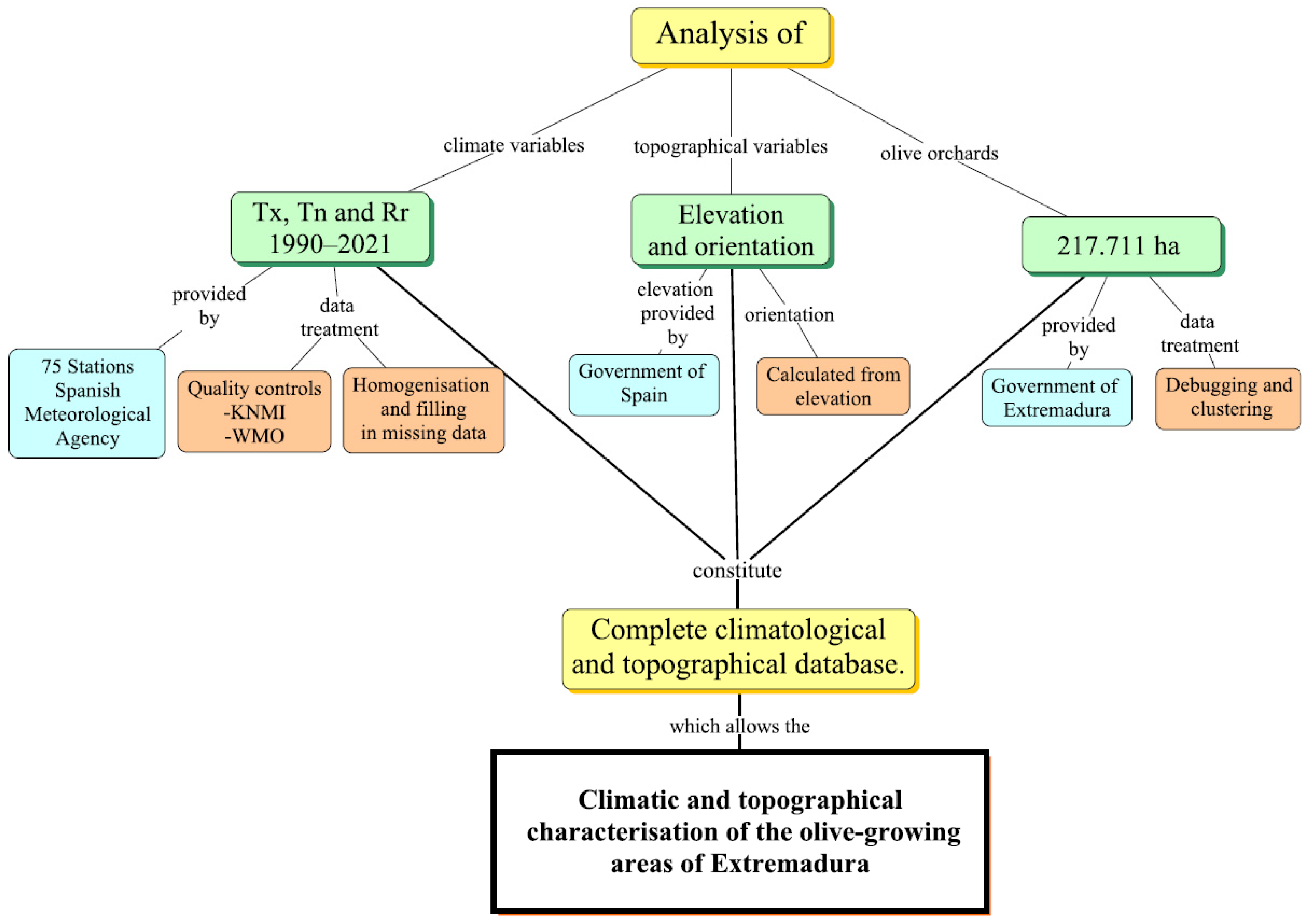
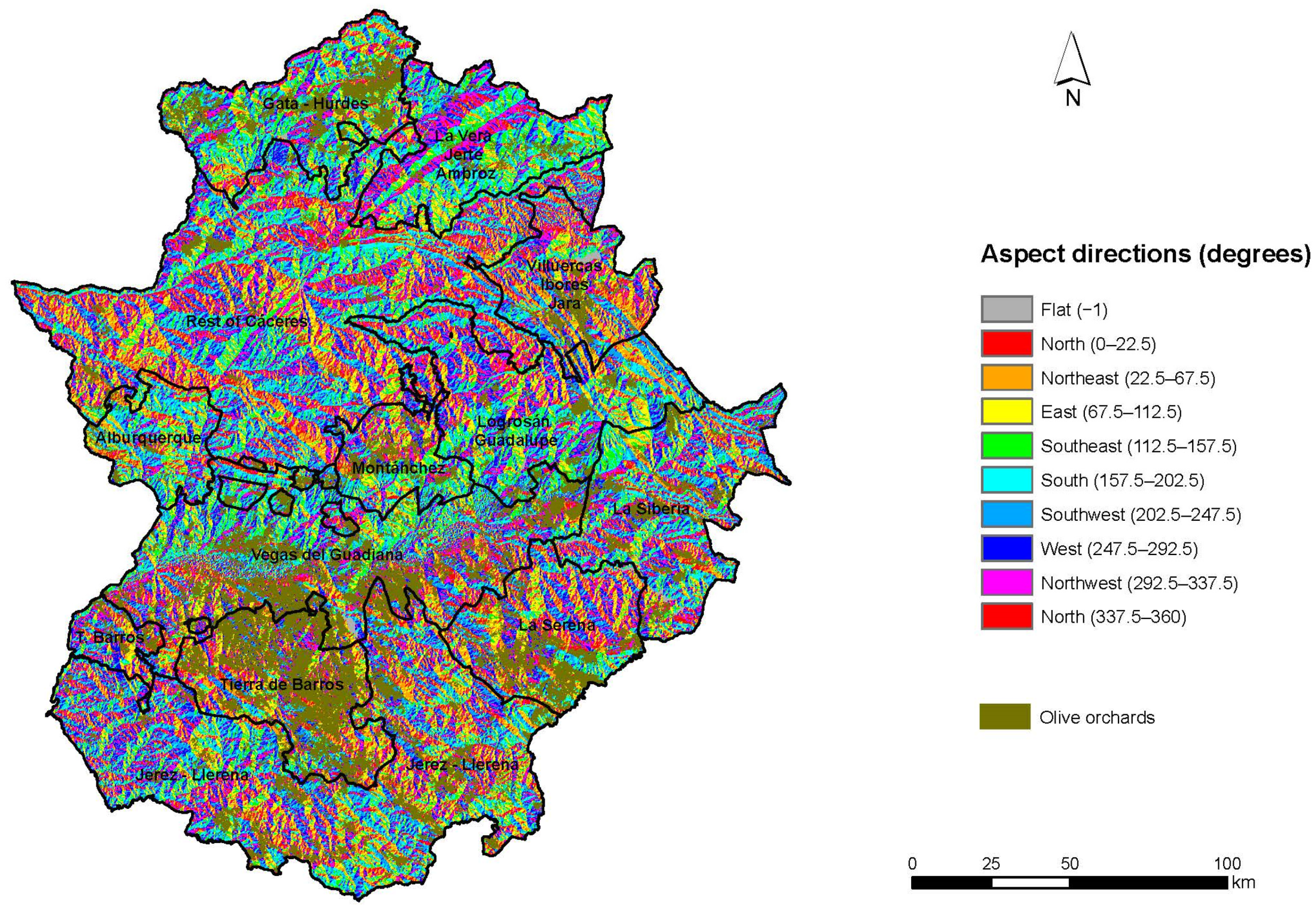


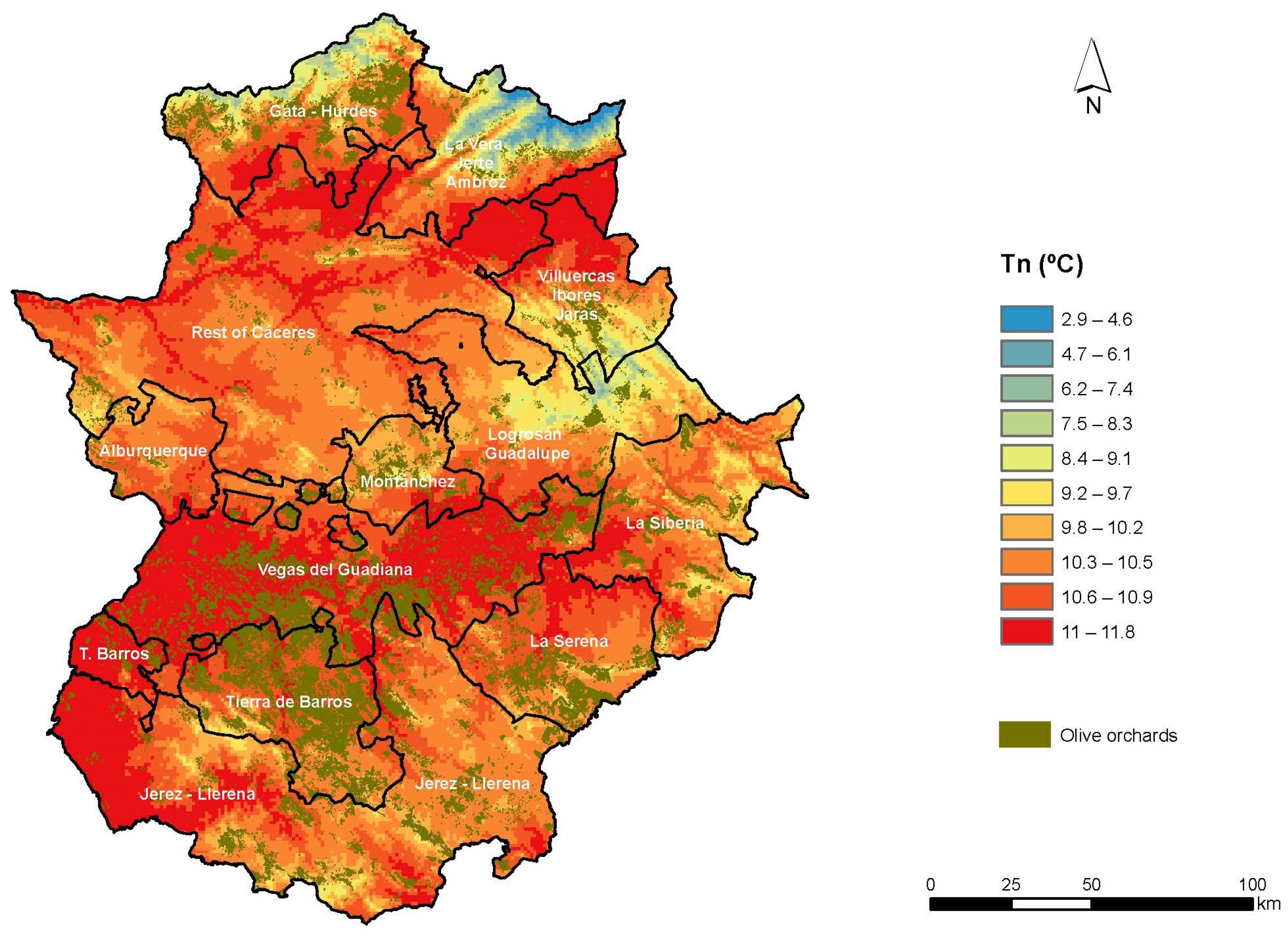
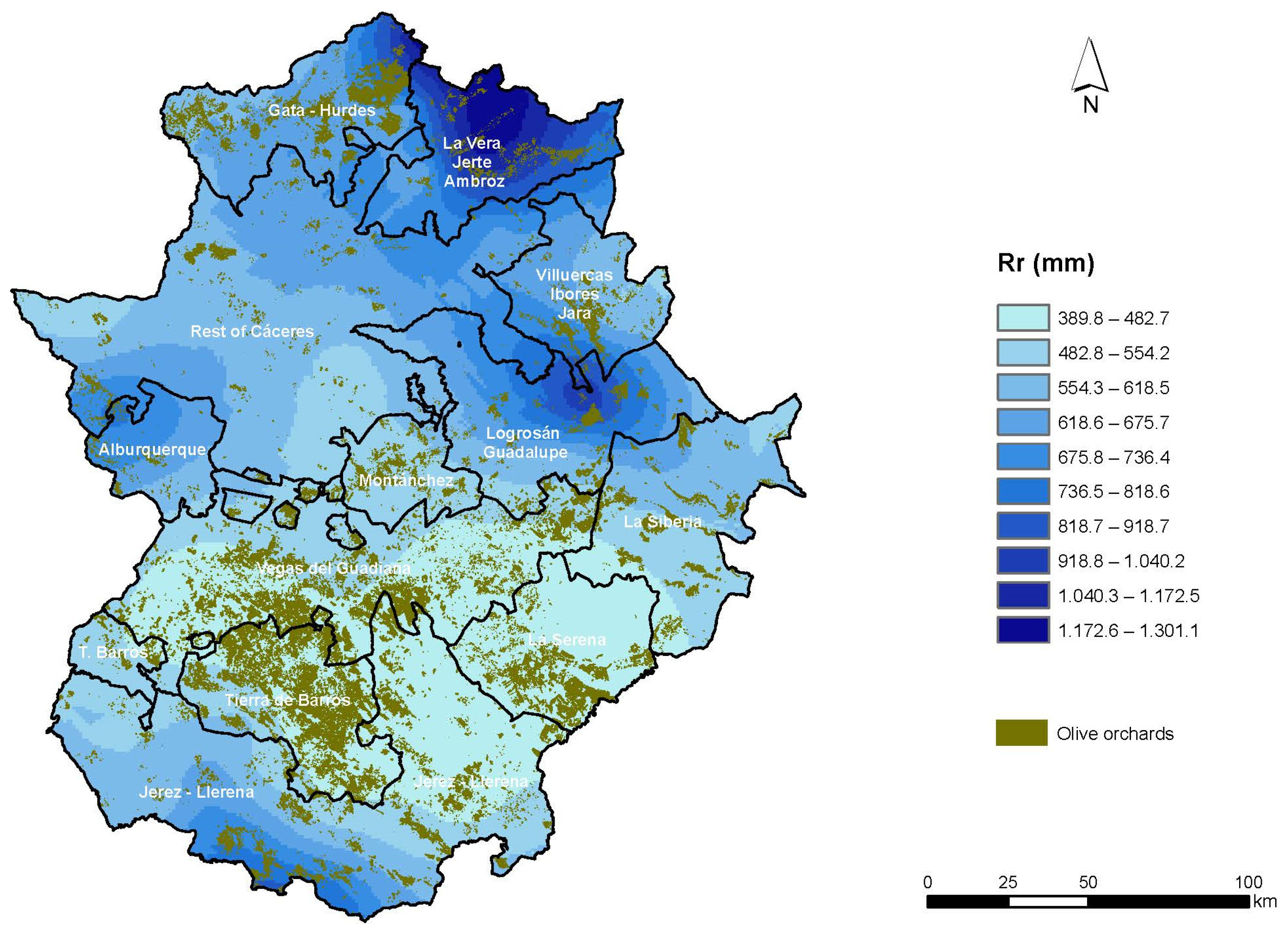
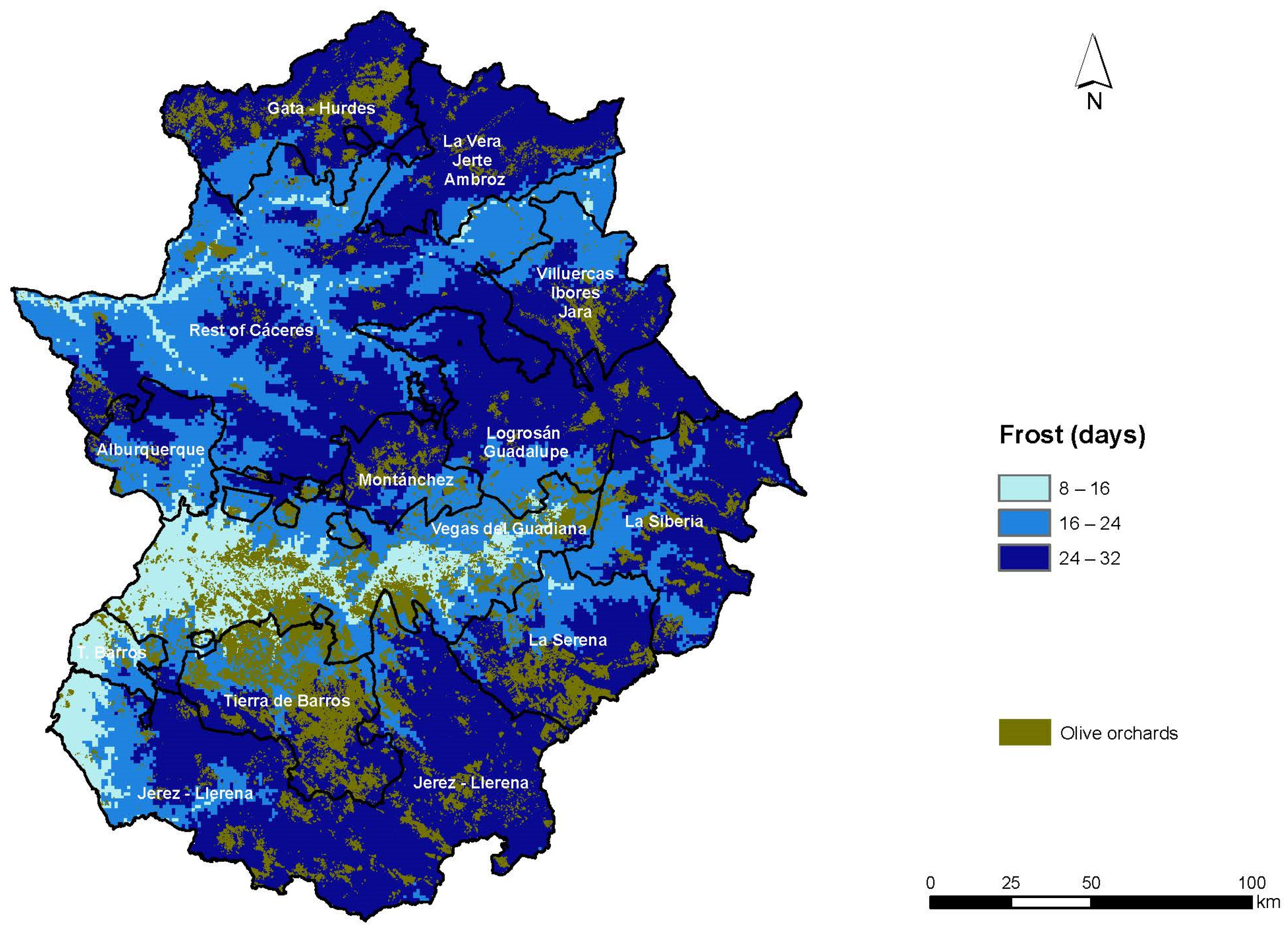


| Olive-Growing Region | Province % | Extremadura % | Total ha | PDO |
|---|---|---|---|---|
| Alburquerque | 3.5 | 2.8 | 6187 | |
| La Siberia | 6.5 | 5.3 | 11,463 | PDO Monterrubio |
| La Serena | 10.5 | 8.5 | 18,487 | PDO Monterrubio |
| Jerez-Llerena | 18.5 | 15.0 | 32,708 | |
| Tierra de Barros | 28,9 | 23.5 | 51,155 | |
| Vegas de Guadiana | 32.1 | 26.1 | 56,783 | |
| Total Badajoz | 100 | 81.2 | 176,783 | |
| La Vera-Jerte-Ambroz | 4.5 | 0.8 | 1836 | PDO Gata-Hurdes |
| Ibores | 11.9 | 2.2 | 4889 | PDO Villuercas-Ibores-Jara |
| Montánchez | 11.9 | 2.2 | 4876 | |
| Logrosán Guadalupe | 15.7 | 2.9 | 6408 | |
| Resto de Cáceres | 16.6 | 3.1 | 6774 | |
| Gata Hurdes | 39.4 | 7.4 | 16,145 | PDO Gata-Hurdes |
| Total Cáceres | 100 | 18.8 | 40,928 | |
| Total Extremadura | 100 | 217,711 |
| Variables | Definition of Variables | Source |
|---|---|---|
| Tx | Average maximum temperature for the period 1990–2021 | AEMET [53] |
| Tn | Average minimum temperature for the period 1990–2021 | AEMET [53] |
| Tavg | Average temperature for the period 1990–2021 | AEMET [53] |
| Rr | Average annual precipitation for the period 1990–2021 | AEMET [53] |
| FD | Number of frost days: number of days with minimum temperature below 0 °C in the period 1990–2021 | García-Martín et al. [58] |
| SF | Number of severe frost days: No. of days with minimum temperature below −4.7 °C for the period 1990–2021 | Lodolini et al., 2022 [16] |
| Elevation | Terrain elevation obtained from the Digital Terrain Model with 200 m resolution (DEM200) | DEM200 [59] |
| Orientation | Slope direction, expressed in degrees, obtained from DEM200 | Derived from DEM200 |
| Olive-Growing Regions | Altitude Ranges (m) | |||||||
|---|---|---|---|---|---|---|---|---|
| <200 | 200–300 | 300–400 | 400–500 | 500–600 | 600–700 | 700–800 | >800 | |
| La Siberia | 0.0 | 0.0 | 13.2 | 38.1 | 36.3 | 8.8 | 2.9 | 0.6 |
| La Serena | 0.0 | 0.1 | 11.0 | 41.9 | 35.1 | 8.5 | 3.1 | 0.3 |
| Alburquerque | 0.0 | 22.5 | 56.0 | 19.5 | 2.0 | 0.0 | 0.0 | 0.0 |
| Jerez-Llerena | 0.5 | 5.8 | 15.7 | 18.1 | 33.2 | 18.9 | 6.8 | 0.9 |
| Tierra de Barros | 0.5 | 20.6 | 34.5 | 25.7 | 17.4 | 1.2 | 0.1 | 0.0 |
| Vegas del Guadiana | 6.4 | 65.9 | 25.7 | 1.4 | 0.4 | 0.2 | 0.0 | 0.0 |
| Total Badajoz | 1.9 | 24.7 | 24.9 | 20.6 | 19.4 | 6.2 | 2.1 | 0.3 |
| La Vera-Jerte-Ambroz | 0.0 | 0.0 | 11.0 | 36.1 | 17.9 | 12.3 | 8.8 | 13.9 |
| Gata-Hurdes | 0.0 | 0.2 | 11.3 | 45.4 | 19.7 | 10.8 | 6.3 | 6.3 |
| Montánchez | 0.0 | 2.4 | 21.0 | 60.6 | 12.0 | 2.3 | 1.3 | 0.3 |
| Logrosán-Guadalupe | 0.0 | 4.5 | 15.3 | 18.2 | 22.8 | 15.1 | 11.5 | 12.5 |
| Ibores | 0.0 | 6.3 | 23.4 | 16.3 | 22.6 | 21.8 | 7.3 | 2.3 |
| Resto de Cáceres | 0.9 | 11.5 | 49.1 | 27.4 | 7.8 | 3.0 | 0.4 | 0.0 |
| Total Cáceres | 0.2 | 3.7 | 21.1 | 35.6 | 17.2 | 10.5 | 5.8 | 5.8 |
| Total Extremadura | 1.3 | 17.8 | 23.6 | 25.6 | 18.7 | 7.6 | 3.3 | 2.1 |
| Weather stations | 3 | 14 | 13 | 11 | 13 | 10 | 7 | 4 |
| Olive-Growing Regions * | Types of Orientation | |||||||
|---|---|---|---|---|---|---|---|---|
| NO | N | NE | E | SE | S | SO | O | |
| Alburquerque | 8.5 | 3.0 | 8.1 | 7.2 | 14.0 | 22.3 | 21.9 | 14.9 |
| La Serena | 9.1 | 7.9 | 16.4 | 15.6 | 11.8 | 13.4 | 13.9 | 11.8 |
| Jerez-Llerena | 9.7 | 5.3 | 17.5 | 14.5 | 9.9 | 11.4 | 16.5 | 15.3 |
| La Siberia | 11.8 | 7.9 | 13.0 | 9.1 | 9.3 | 12.6 | 19.5 | 16.8 |
| Vegas del Guadiana | 12.1 | 4.8 | 9.9 | 11.0 | 14.0 | 14.8 | 16.9 | 16.6 |
| Tierra de Barros | 12.7 | 5.6 | 15.8 | 14.8 | 9.8 | 9.8 | 14.4 | 17.0 |
| Total Badajoz | 11.4 | 5.6 | 13.8 | 13.0 | 11.5 | 12.7 | 16.2 | 15.9 |
| Gata-Hurdes | 7.8 | 3.6 | 6.3 | 12.9 | 19.7 | 20.2 | 16.4 | 12.9 |
| La Vera-Jerte-Ambroz | 8.3 | 3.1 | 2.8 | 7.2 | 23.8 | 30.0 | 15.1 | 9.7 |
| Logrosán-Guadalupe | 9.1 | 1.5 | 3.9 | 8.0 | 20.5 | 22.4 | 18.3 | 16.3 |
| Ibores | 9.7 | 6.0 | 16.0 | 12.6 | 8.4 | 10.2 | 17.3 | 19.8 |
| Montánchez | 11.8 | 5.2 | 8.6 | 11.2 | 13.0 | 15.2 | 19.5 | 15.5 |
| Resto de Cáceres | 14.4 | 7.2 | 12.5 | 10.4 | 11.9 | 15.4 | 15.6 | 12.6 |
| Total Cáceres | 9.8 | 4.3 | 8.2 | 11.3 | 16.6 | 18.4 | 16.9 | 14.4 |
| Total Extremadura | 11.1 | 5.3 | 12.8 | 12.6 | 12.4 | 13.8 | 16.3 | 15.6 |
| Pearson Correlation | ||||||
|---|---|---|---|---|---|---|
| Variables | Tx | Tn | Tavg | RR | FD | SF |
| Altitude | −0.823 ** | −0.669 ** | −0.819 ** | 0.385 ** | 0.577 ** | 0.536 ** |
| Longitude | 0.005 | −0.179 | −0.094 | −0.140 | 0.259 * | 0.187 |
| Latitude | −0.577 ** | −0.513 ** | −0.598 ** | 0.230 * | 0.504 ** | 0.460 ** |
| Dependent Variable | Independent Variables | Equations | R2 |
|---|---|---|---|
| Tx | Altitude, Latitude | 0.77 | |
| Tn | Altitude, Latitude | 0.53 | |
| Tavg | Altitude, Latitude | 0.78 | |
| FD | Altitude, Latitude | 0.43 |
| Olive-Growing Regions | Rr (mm) | Tavg (°C) | Tx (°C) | Tn (°C) | ||||
|---|---|---|---|---|---|---|---|---|
| Mean | CV (%) | Mean | CV (%) | Mean | CV (%) | Mean | CV (%) | |
| La Serena | 428 | 3.0 | 16.6 | 2.4 | 22.7 | 2.3 | 10.4 | 3.3 |
| Tierra de Barros | 460 | 7.0 | 16.8 | 2.1 | 22.9 | 1.8 | 10.7 | 2.6 |
| Vegas del Guadiana | 469 | 6.0 | 17.3 | 1.2 | 23.5 | 1.5 | 11.0 | 1.7 |
| Jerez-Llerena | 533 | 20.0 | 16.5 | 3.0 | 22.6 | 3.4 | 10.4 | 3.7 |
| La Siberia | 534 | 8.0 | 16.5 | 3.1 | 22.8 | 2.9 | 10.3 | 4.2 |
| Alburquerque | 563 | 11.0 | 16.7 | 2.0 | 23.0 | 2.2 | 10.6 | 2.4 |
| Total Badajoz | 485 | 14.0 | 16.8 | 2.9 | 22.9 | 2.8 | 10.6 | 3.7 |
| Montánchez | 531 | 3.0 | 16.3 | 3.3 | 22.5 | 2.8 | 10.2 | 4.3 |
| Resto de Cáceres | 627 | 8.0 | 16.4 | 2.5 | 22.2 | 2.4 | 10.5 | 3.4 |
| Ibores | 665 | 8.0 | 15.7 | 4.1 | 21.4 | 3.6 | 9.8 | 5.7 |
| Gata-Hurdes | 685 | 10.0 | 15.8 | 4.1 | 21.3 | 3.6 | 10.2 | 4.8 |
| Logrosán-Guadalupe | 719 | 18.0 | 15.8 | 6.5 | 22.3 | 5.6 | 9.7 | 8.5 |
| La Vera-Jerte-Ambroz | 1021 | 13.0 | 15.3 | 6.7 | 21.4 | 5.6 | 9.6 | 8.7 |
| Total Cáceres | 690 | 20.0 | 15.9 | 4.8 | 21.6 | 4.4 | 10.1 | 6.1 |
| Total Extremadura | 550 | 25.0 | 16.5 | 4.4 | 22.5 | 4.3 | 10.4 | 5.1 |
| Olive-Growing Regions | Tavg Ranges (°C) | Area Olive Grove (ha) | |||
|---|---|---|---|---|---|
| <15 °C | 15–16 °C | 16–17 °C | 17–18.2 °C | ||
| Vegas del Guadiana | 0.0 | 0.2 | 3.6 | 96.2 | 56,783 |
| Tierra de Barros | 0.0 | 1.7 | 53.7 | 44.6 | 51,155 |
| Alburquerque | 0.0 | 8.9 | 78.1 | 13.0 | 6187 |
| Jerez-Llerena | 0.1 | 14.4 | 65.2 | 20.4 | 32,708 |
| La Serena | 0.2 | 12.3 | 78.3 | 9.2 | 18,487 |
| La Siberia | 0.3 | 20.5 | 59.6 | 19.7 | 11,463 |
| Total Badajoz | 0.0 | 6.1 | 43.5 | 50.3 | 176,783 |
| Resto de Cáceres | 0.1 | 19.7 | 68.7 | 11.5 | 6774 |
| Montánchez | 2.1 | 19.9 | 65.7 | 12.3 | 4876 |
| Ibores | 6.3 | 66.2 | 22.0 | 5.5 | 4889 |
| Gata-Hurdes | 8.6 | 60.4 | 30.9 | 0.0 | 16,145 |
| Logrosán-Guadalupe | 12.3 | 28.1 | 24.6 | 34.9 | 6408 |
| La Vera-Jerte-Ambroz | 22.6 | 36.1 | 38.8 | 2.5 | 1836 |
| Total Cáceres | 7.4 | 43.4 | 39.7 | 9.6 | 40,928 |
| Total Extremadura | 1.4 | 13.1 | 42.8 | 42.6 | 217,711 |
| Olive-Growing Regions | Tx Ranges (°C) | Area (ha) Olive Grove | ||||
|---|---|---|---|---|---|---|
| <19.5 °C | 19.5–21.5 °C | 21.5–22.1 °C | 22.1–23.3 °C | 23.3–24.5 °C | ||
| Vegas del Guadiana | 0.0 | 0.0 | 0.2 | 36.8 | 63.0 | 56,783 |
| Tierra de Barros | 0.0 | 0.1 | 4.3 | 85.9 | 9.8 | 51,155 |
| Alburquerque | 0.0 | 1.2 | 9.2 | 67.2 | 22.4 | 6187 |
| La Siberia | 0.0 | 4.1 | 6.1 | 62.8 | 27.1 | 11,463 |
| La Serena | 0.0 | 4.3 | 9.2 | 78.8 | 7.6 | 18,487 |
| Jerez-Llerena | 0.0 | 6.2 | 14.1 | 60.5 | 19.3 | 32,708 |
| Total Badajoz | 0.0 | 1.9 | 5.6 | 62.5 | 30.0 | 176,783 |
| Montánchez | 0.0 | 4.9 | 6.2 | 76.5 | 12.3 | 4876 |
| Resto de Cáceres | 0.0 | 7.0 | 21.5 | 68.5 | 3.1 | 6774 |
| Ibores | 0.4 | 58.8 | 21.9 | 16.0 | 2.8 | 4889 |
| Logrosán-Guadalupe | 1.8 | 19.7 | 12.9 | 20.7 | 45.0 | 6408 |
| Gata-Hurdes | 2.3 | 56.9 | 32.6 | 8.2 | 0.0 | 16,145 |
| La Vera-Jerte-Ambroz | 4.1 | 29.5 | 14.3 | 49.6 | 2.4 | 1836 |
| Total Cáceres | 1.4 | 35.6 | 22.4 | 31.1 | 9.5 | 40,928 |
| Total Extremadura | 0.2 | 8.3 | 8.8 | 56.6 | 26.1 | 217,711 |
| Olive-Growing Regions | Tn Ranges (°C) | Area of Olive Grove (ha) | |||
|---|---|---|---|---|---|
| <9 °C | 9–10.2 °C | 10.2–11 °C | 11–11.8 °C | ||
| Vegas del Guadiana | 0.0 | 0.5 | 22.3 | 77.3 | 56,783 |
| Tierra de Barros | 0.0 | 7.2 | 68.3 | 24.4 | 51,155 |
| Alburquerque | 0.0 | 11.5 | 80.6 | 7.9 | 6187 |
| Jerez-Llerena | 0.0 | 24.8 | 63.0 | 12.1 | 32,708 |
| La Serena | 0.6 | 24.1 | 73.0 | 2.2 | 18,487 |
| La Siberia | 0.7 | 38.8 | 56.4 | 4.0 | 11,463 |
| Total Badajoz | 0.1 | 12.2 | 52.7 | 34.9 | 176,783 |
| Resto de Cáceres | 0.0 | 19.1 | 65.0 | 15.9 | 6774 |
| Montánchez | 2.1 | 38.9 | 51.4 | 7.7 | 4876 |
| Gata-Hurdes | 2.8 | 35.7 | 60.3 | 1.3 | 16,145 |
| Ibores | 6.3 | 71.8 | 16.2 | 5.6 | 4889 |
| Logrosán-Guadalupe | 14.4 | 32.0 | 44.2 | 9.4 | 6408 |
| La Vera-Jerte-Ambroz | 18.6 | 34.0 | 44.6 | 2.8 | 1836 |
| Total Cáceres | 5.1 | 36.9 | 51.6 | 6.3 | 40,928 |
| Total Extremadura | 1.0 | 16.9 | 52.5 | 29.5 | 217,711 |
| Olive-Growing Regions | Rr Ranges (mm) | |||||||
|---|---|---|---|---|---|---|---|---|
| <490 | 490–600 | 601–715 | 715–800 | 800–900 | 900–1020 | 1020–1150 | >1150 | |
| La Siberia | 11.9 | 76 | 12.1 | |||||
| Jerez-Llerena | 51.8 | 28.9 | 8.9 | 8.2 | 2.2 | |||
| Vegas del Guadiana | 75.1 | 24.9 | ||||||
| Tierra de Barros | 82.1 | 17.9 | ||||||
| La Serena | 100.0 | |||||||
| Alburquerque | 74.6 | 19.8 | 5.5 | |||||
| Total Badajoz | 68.7 | 26.0 | 3.1 | 1.7 | 0.4 | |||
| La Vera-Jerte-Ambroz | 12.0 | 4.2 | 16 | 30.0 | 27.7 | 10.2 | ||
| Gata-Hurdes | 3.3 | 76.1 | 10.1 | 9.5 | 1.1 | |||
| Ibores | 18.9 | 65.0 | 14.8 | 1.2 | 0.2 | |||
| Resto de Cáceres | 37.9 | 53.8 | 8.3 | |||||
| Logrosán-Guadalupe | 50.0 | 18.6 | 6.6 | 21.9 | 2.8 | |||
| Montánchez | 100.0 | |||||||
| Total Cáceres | 29.6 | 50.2 | 8.3 | 8.0 | 2.2 | 1.3 | 0.5 | |
| Total Extremadura | 55.8 | 26.7 | 12 | 2.9 | 1.8 | 0.4 | 0.2 | 0.1 |
| Olive-Growing Regions | Number of Frost Days | Area of Olive Grove (ha) | ||
|---|---|---|---|---|
| 8–15 | 16–23 | 24–32 | ||
| Jerez-Llerena | 2.0 | 16.8 | 81.2 | 32,708 |
| La Serena | 0.0 | 6.9 | 93.0 | 18,487 |
| La Siberia | 0.0 | 21.3 | 78.7 | 11,463 |
| Alburquerque | 3.3 | 60.7 | 36.1 | 6187 |
| Tierra de Barros | 9.7 | 41.5 | 48.8 | 51,155 |
| Vegas del Guadiana | 49.6 | 48.6 | 1.8 | 56,783 |
| Total Badajoz | 19.3 | 34.9 | 45.8 | 176,773 |
| Gata-Hurdes | 0.0 | 2.2 | 97.8 | 16,145 |
| Ibores | 0.0 | 8.1 | 91.8 | 4889 |
| Montánchez | 0.0 | 16.3 | 83.7 | 4876 |
| La Vera-Jerte-Ambroz | 0.1 | 5.3 | 94.5 | 1836 |
| Resto de Cáceres | 1.9 | 48.9 | 49.2 | 6774 |
| Logrosán-Guadalupe | 2.4 | 44.5 | 53.1 | 6408 |
| Total Cáceres | 0.7 | 19.1 | 80.2 | 40,939 |
| Total Extremadura | 15.7 | 32.0 | 52.3 | 217,711 |
| Olive-Growing Regions | Probability of Number of Severe Frost Days | |||
|---|---|---|---|---|
| 1 SF/year | 1–5 SF/year | 5–10 SF/year | +10 SF/year | |
| Serena | 3.1 | 1.6 | 0.0 | 0.0 |
| Jerez-Llerena | 4.5 | 4.5 | 0.3 | 0.0 |
| Vegas del Guadiana | 4.5 | 8.0 | 0.0 | 0.0 |
| Alburquerque | 4.7 | 0.0 | 0.0 | 0.0 |
| Siberia | 7.8 | 4.7 | 0.0 | 0.0 |
| Tierra de Barros | 8.6 | 7.8 | 0.8 | 0.0 |
| Total Badajoz | 5.5 | 4.4 | 0.2 | 0.0 |
| Resto de Cáceres | 1.5 | 0.0 | 0.0 | 0.0 |
| Montánchez | 1.6 | 0.0 | 0.0 | 0.0 |
| Gata-Hurdes | 8.3 | 4.2 | 0.0 | 0.0 |
| Ibores | 11.5 | 8.3 | 0.0 | 0.0 |
| Logrosán-Guadalupe | 11.5 | 17.7 | 2.1 | 3.1 |
| La Vera-Jerte-Ambroz | 12.5 | 12.5 | 1.0 | 0.0 |
| Toral Cáceres | 7.6 | 7.1 | 0.5 | 0.5 |
| Extremadura | 6.5 | 5.8 | 0.4 | 0.3 |
| Altitude Ranges | Climate Variables | |||
|---|---|---|---|---|
| RR (mm) | Tavg (°C) | Tn (°C) | Tx (°C) | |
| <200 | 472 | 17.5 | 11.3 | 23.5 |
| 200–300 | 475 | 17.3 | 11.0 | 23.4 |
| 300–400 | 511 | 17.0 | 10.8 | 23.1 |
| 400–500 | 563 | 16.5 | 10.5 | 22.4 |
| 500–600 | 550 | 16.2 | 10.2 | 22.2 |
| 600–700 | 642 | 15.7 | 9.8 | 21.4 |
| 700–800 | 706 | 15.1 | 9.4 | 20.8 |
| >800 | 834 | 14.2 | 8.7 | 19.9 |
Disclaimer/Publisher’s Note: The statements, opinions and data contained in all publications are solely those of the individual author(s) and contributor(s) and not of MDPI and/or the editor(s). MDPI and/or the editor(s) disclaim responsibility for any injury to people or property resulting from any ideas, methods, instructions or products referred to in the content. |
© 2024 by the authors. Licensee MDPI, Basel, Switzerland. This article is an open access article distributed under the terms and conditions of the Creative Commons Attribution (CC BY) license (https://creativecommons.org/licenses/by/4.0/).
Share and Cite
Honorio, F.; Aguirado, C.; Paniagua, L.L.; García-Martín, A.; Rebollo, L.; Rebollo, F.J. Exploring the Climate and Topography of Olive Orchards in Extremadura, Southwestern Spain. Land 2024, 13, 495. https://doi.org/10.3390/land13040495
Honorio F, Aguirado C, Paniagua LL, García-Martín A, Rebollo L, Rebollo FJ. Exploring the Climate and Topography of Olive Orchards in Extremadura, Southwestern Spain. Land. 2024; 13(4):495. https://doi.org/10.3390/land13040495
Chicago/Turabian StyleHonorio, Fulgencio, Cristina Aguirado, Luis L. Paniagua, Abelardo García-Martín, Lourdes Rebollo, and Francisco J. Rebollo. 2024. "Exploring the Climate and Topography of Olive Orchards in Extremadura, Southwestern Spain" Land 13, no. 4: 495. https://doi.org/10.3390/land13040495
APA StyleHonorio, F., Aguirado, C., Paniagua, L. L., García-Martín, A., Rebollo, L., & Rebollo, F. J. (2024). Exploring the Climate and Topography of Olive Orchards in Extremadura, Southwestern Spain. Land, 13(4), 495. https://doi.org/10.3390/land13040495







